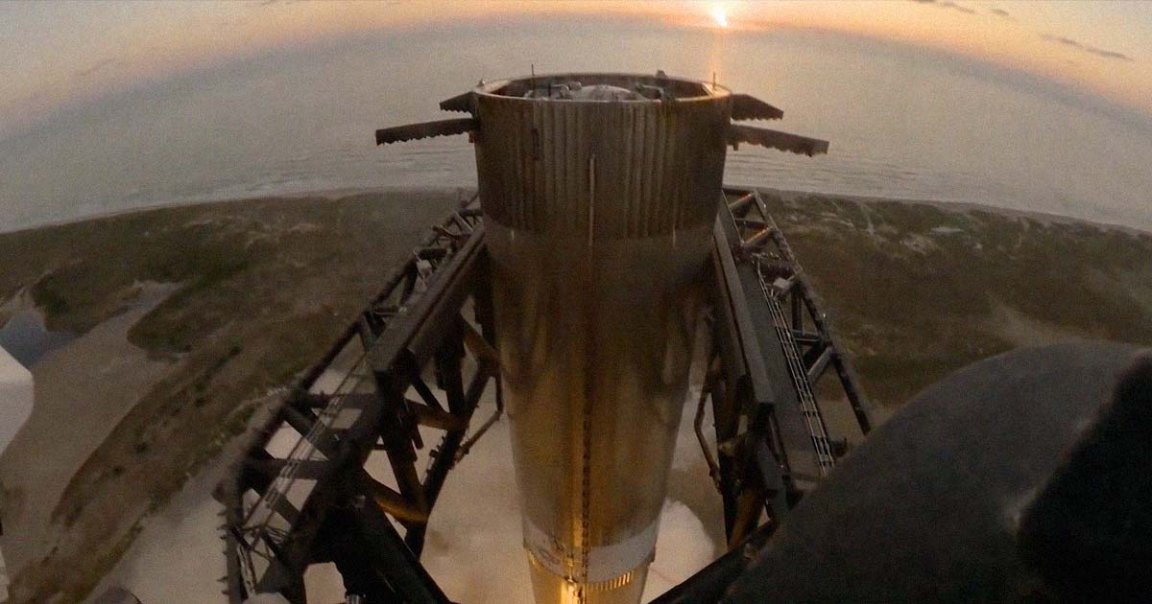
Roaring Start
The fifth orbital flight test of SpaceX’s Starship was a resounding, astonishing success.
Now, courtesy of new footage released by the aerospace company, we get to witness the launch of the world’s most powerful rocket up close, where its sheer size and thunderous power are enough to overwhelm you even through a computer screen.
The launch took place Sunday morning at SpaceX’s Starbase facility in Boca Chica, Texas.
As seen in a video taken from the launch tower, the rocket’s lower stage, the Super Heavy Booster, fires all 33 of its Raptor engines, generating an eye-watering 16.7 million pounds of thrust that kicks up a raging inferno below. Then, slowly, the entire rocket — all 398 feet of it — begins to heave into the air.
Towering as Starship is, from the camera’s perspective it almost looks like we’re falling past a skyscraper as it takes to the sky, half wrapped in a fluffy shell of water vapor. The last thing we see is the Sun-like image of the Raptor engines, blasting flames onto the lens.
Perfect Catch
That’s an impressive spectacle in its own right. But what really stole the show that day was the ambitious and highly unorthodox landing of the Super Heavy booster.
Both stages performed admirably. The upper stage consisting of the Starship vehicle separated after three minutes and forty seconds after liftoff, and then used its six Raptor engines to power itself into space, reaching an altitude of around 90 miles, according to The Guardian. It would later return with a more or less conventional splashdown in the Gulf of Mexico, sustaining considerably less damage during its descent than on its last run, but exploded after all was said and done.
Meanwhile, the Super Heavy booster, post-breakup, immediately reversed course back to its Starbase launchpad, where “Mechazilla,” the launch tower, was waiting to “catch” it. The booster fired 13 engines in a braking burn for most of the way down. Once it neared the tower, it opted to use just three engines for more control.
In a stunning technical achievement, the 233-foot-tall Super Heavy guides itself into the “chopstick” arms of the launch tower, slowing to a hover with dumbfounding accuracy into the middle of the closing mechanical claw. And voilà: with the rocket’s metal protrusions safely hooked onto Mechazilla, SpaceX pulled off the near-impossible.
Building on Success
Super Heavy’s landing feat is a major stepping stone towards SpaceX’s plans to run Starship as a reusable rocket — and it pretty much couldn’t have gone any better. There’s no doubt that the rocket has come a long way from exploding during its first two orbital flight tests.
What SpaceX plans to do next is unclear. The Federal Aviation Administration has already approved Starship’s next, sixth flight, which hasn’t come easy in the past. But if SpaceX changes up its plan for the next test, it may need to re-apply for approval.
Regardless, this is the most encouraging progress SpaceX has made with the rocket yet — a reassuring step towards it eventually being the vehicle that brings NASA astronauts to the surface of the Moon.
More on SpaceX: Dramatic Footage Shows SpaceX Starship Exploding After Crashing Into the Ocean